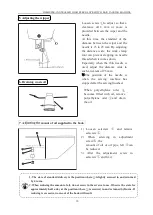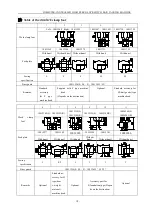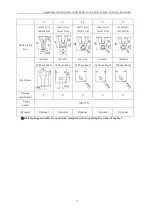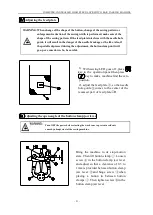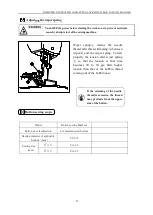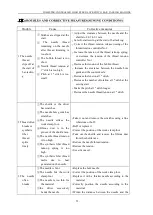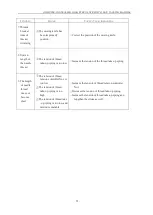
COMPUTER-CONTROLLED HIGH SPEED LOCKSTITCH BAR TACKING MACHINE
-
-
.T
Trouble
Cause
Corrective measures
1.The needle
thread
slips off at
the start of
bar-tackin
g
Stitches are slipped at the
start
The
needle
thread
remaining on the needle
after thread trimming is
too short.
The bobbin thread is too
short.
Needle thread tension at
1
st
stitch is too high.
Pitch at 1
st
stitch is too
small.
Adjust the clearance between the needle and the
shuttle to 0.05 to 0.1mm.
Set soft-start sewing at the start of bar tacking.
Correct the thread tension release timing of the
thread tension controller No.2.
Increase the tension of the thread take-up spring,
or decrease the tension of the thread tension
controller No.1.
Decrease the tension of the bobbin thread.
Increase the clearance between the needle hole
guide and the counter knife.
Decrease the tension at 1
st
stitch.
Decrease the number of rotation at 1
st
stitch at the
sewing start.
Make the pitch at 1
st
stitch longer.
Decrease the needle thread tension at 1
st
stitch
2.Thread often
breaks or
synthetic
fiber
thread
splits
finely.
The shuttle or the driver
has scratches.
The needle hole guide has
scratches.
The needle strikes the
work clamp foot.
Fibrous dust is in the
groove of the shuttle race.
The needle thread tension
is too high.
The synthetic fiber thread
take-up spring is too
high.
The synthetic fiber thread
melts
due
to
heat
generated on the needle.
Take it out and remove the scratches using a fine
whetstone or buff.
Buff or replace it.
Correct the position of the work clamp foot.
Take out the shuttle and remove the fibrous dust
from the shuttle race.
Reduce the needle thread tension.
Reduce the tension.
Use silicone oil .
3.The needle
often
breaks.
The needle is bent.
The needle hits the work
clamp foot.
The needle is too thin for
the material.
the driver excessively
bends the needle.
Replace the bent needle.
Correct the position of the work clamp foot.
Replace it with a thicker needle according to the
material.
Correctly position the needle according to the
material.
Widen the distance between the needle and the
.



